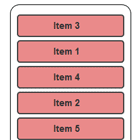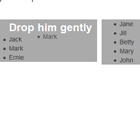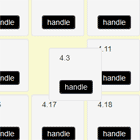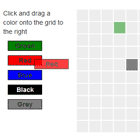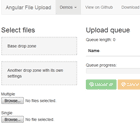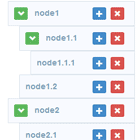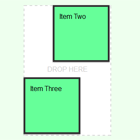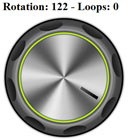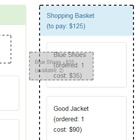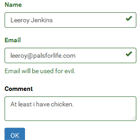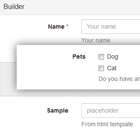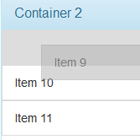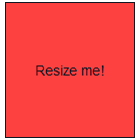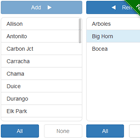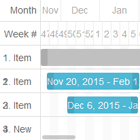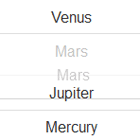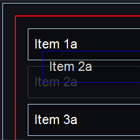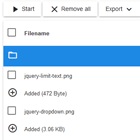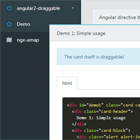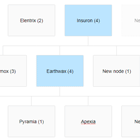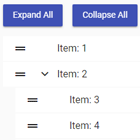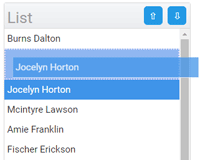UI.Sortable directive
This directive allows you to sort an array with drag & drop.
Requirements
- JQuery v3.1+ (for jQuery v1.x & v2.x use v0.14.x versions)
- JQueryUI v1.12+
- AngularJS v1.2+
Single minified cdn link ~245kB and example with JQuery v1.x, required parts of JQueryUI v1.10, AngularJS v1.2 & latest angular-ui-sortable.
Notes:
- JQuery must be included before AngularJS.
- JQueryUI dependecies include widget, data, scroll-parent, mouse & sortable. Creating a custom build will greatly reduce the required file size. (CDN links for comparison: full vs minimal)
- Users of AngularJS pre v1.2 can use v0.10.x or v0.12.x branches.
- Early adopters of Angular2 can use the ng2 branch.
Installation
- Install with Bower
bower install -S angular-ui-sortable - Install with npm
npm install -S angular-ui-sortable - Download one of the Releases or the latest Master branch
Usage
Load the script file: sortable.js in your application:
<script type="text/javascript" src="modules/directives/sortable/src/sortable.js"></script>Add the sortable module as a dependency to your application module:
var myAppModule = angular.module('MyApp', ['ui.sortable'])Apply the directive to your form elements:
<ul ui-sortable ng-model="items"> <li ng-repeat="item in items">{{ item }}</li> </ul>Developing Notes:
ng-modelis required, so that the directive knows which model to update.ui-sortableelement should contain only oneng-repeat, but other non-repeater elements above or below may still exist. Otherwise the index matching of theng-model's items and the DOM elements generated by theng-repeatwill break.
In other words: The items ofng-modelmust match the indexes of the DOM elements generated by theng-repeat.Filtersthat manipulate the model (like filter, orderBy, limitTo,...) should be applied in thecontrollerinstead of theng-repeat(refer to the provided examples).
This is the preferred way since it:- is performance wise better
- reduces the chance of code duplication
- is suggested by the angularJS team
- it does not break the matching of the generated DOM elements and the
ng-model's items
ui-sortablelists containing many 'types' of items can be implemented by using dynamic template loading with ng-include or a loader directive, to determine how each model item should be rendered. Also take a look at the Tree with dynamic template example.
Options
All the jQueryUI Sortable options can be passed through the directive.
Additionally, the ui argument of the available callbacks gets enriched with some extra properties as specified to the API.md file. Any model changes that happen inside the available callbacks, are applied right after the stop event. We are not wrapping callbacks like start/change/... with $apply, in order to minimize the number of digest loops and avoid possible modifications of the model (eg: by watchers) before the drop takes place.
myAppModule.controller('MyController', function($scope) { $scope.items = ["One", "Two", "Three"]; $scope.sortableOptions = { update: function(e, ui) { ... }, axis: 'x' }; });<ul ui-sortable="sortableOptions" ng-model="items"> <li ng-repeat="item in items">{{ item }}</li> </ul>When using event callbacks (start/update/stop...), avoid manipulating DOM elements (especially the one with the ng-repeat attached). The suggested pattern is to use callbacks for emmiting events and altering the scope (inside the 'Angular world').
ui-floating
ui-floating (default: undefined)
Description: Enables a workaround for smooth horizontal sorting.
Type: Boolean/String/undefined
- undefined: Relies on jquery.ui to detect the list's orientation.
- false: Forces jquery.ui.sortable to detect the list as vertical.
- true: Forces jquery.ui.sortable to detect the list as horizontal.
- "auto": Detects on each drag
startif the element is floating or not.
To have a smooth horizontal-list reordering, jquery.ui.sortable needs to detect the orientation of the list. This detection takes place during the initialization of the plugin (and some of the checks include: whether the first item is floating left/right or if 'axis' parameter is 'x', etc). There is also a known issue about initially empty horizontal lists.
To provide a solution/workaround (till jquery.ui.sortable.refresh() also tests the orientation or a more appropriate method is provided), ui-sortable directive provides a ui-floating option as an extra to the jquery.ui.sortable options.
<ul ui-sortable="{ 'ui-floating': true }" ng-model="items"> <li ng-repeat="item in items">{{ item }}</li> </ul>OR
$scope.sortableOptions = { 'ui-floating': true };<ul ui-sortable="sortableOptions" ng-model="items"> <li ng-repeat="item in items">{{ item }}</li> </ul>ui-model-items
ui-model-items (default: > [ng-repeat],> [data-ng-repeat],> [x-ng-repeat])
Description: Defines which elements should be considered as part of your model.
Type: CSS selector/String
This is the model related counterpart option of jQuery's items option.
ui-preserve-size
ui-preserve-size (default: undefined)
Description: Set's the size of the sorting helper to the size of the original element before the sorting.
Type: Boolean/undefined
This is useful for elements that their size is dependent to other page characteristics. A representative example of such cases are <table> <tr>s and <td>s.
Attributes For Event Handling
To handle events with html bindings just define any expression to listed event attributes. If you defined an attribute for this events and defined callback function in sortableOptions at the same time, the attribute based callback will be called first.
- ui-sortable-start
- ui-sortable-activate
- ui-sortable-before-stop
- ui-sortable-update
- ui-sortable-remove
- ui-sortable-receive
- ui-sortable-deactivate
- ui-sortable-stop
Expression works on update event.
<ul ui-sortable ng-model="items" ui-sortable-update="expression" > <li ng-repeat="item in items">{{ item }}</li> </ul>On update event callBackFunction1 if called before callBackFunction2.
$scope.sortableOptions = { 'update': callBackFunction2 };<ul ui-sortable="sortableOptions" ng-model="items" ui-sortable-update="callBackFunction1" > <li ng-repeat="item in items">{{ item }}</li> </ul>Canceling
Inside the update callback, you can check the item that is dragged and cancel the sorting.
$scope.sortableOptions = { update: function(e, ui) { if (ui.item.sortable.model == "can't be moved") { ui.item.sortable.cancel(); } } };Notes:
updateis the appropriate place to cancel a sorting, since it occurs before any model/scope changes but after the DOM position has been updated. Soui.item.scopeand the directive'sng-model, are equal to the scope before the drag start.- To cancel a sorting between connected lists,
cancelshould be called inside theupdatecallback of the originating list. A simple way to is to use theui.item.sortable.receivedproperty:
update: function(event, ui) { if (// ensure we are in the first update() callback !ui.item.sortable.received && // check that its an actual moving between the two lists ui.item.sortable.source[0] !== ui.item.sortable.droptarget[0] && // check the size limitation ui.item.sortable.model == "can't be moved between lists") { ui.item.sortable.cancel(); } }jQueryUI Sortable Event order
Single sortable demo
create /* dragging starts */ helper start activate /* multiple: sort/change/over/out */ beforeStop update <= call cancel() here if needed deactivate stop Connected sortables demo
list A: create list B: create /* dragging starts from sortable A to B */ list A: helper list A: start list B: activate list A: activate /* both lists multiple: sort/change/over/out */ list A: sort list A: change list B: change list B: over list A: sort list B: out list A: sort list A: beforeStop list A: update <= call cancel() here if needed list A: remove list B: receive list B: update list B: deactivate list A: deactivate list A: stop For more details about the events check the jQueryUI API documentation.
Integrating with directives doing transclusion
Wrap the transclusion directive element with the ui-sortable directive and set the items to target your ng-repeated elements. Following best practices, it is also highly recommended that you add a track by expression to your ng-repeat. Angular Material example.
myAppModule.controller('MyController', function($scope) { $scope.items = ["One", "Two", "Three"]; $scope.sortableOptions = { items: '.sortable-item' // It is suggested to use the most specific cssselector you can, // after analyzing the DOM elements generated by the transclusion directive // eg: items: '> .transclusionLvl1 > .transclusionLvl2 > .sortable-item' }; });<div ui-sortable="sortableOptions" ng-model="items"> <a-transclusion-directive> <div ng-repeat="item in items" class="sortable-item">{{ item }}</div> </a-transclusion-directive> </div>Examples
- Simple Demo
- Connected Lists
- Filtering (details)
- Ordering 1 & Ordering 2 (details)
- Cloning (details)
- Horizontal List
- Tree with dynamic template
- Canceling
- Locked Items
- Draggable Handle
- Drop Zone
- Draggable-Sortable like interaction
- Static HTML Sorting
Integrations
- firebase
- ui.bootstrap.accordion
- Angular Material (thanks yenoh2)
- Asynchronous loading jQuery+jQueryUI with crisbeto/angular-ui-sortable-loader
Reporting Issues
The above pen's are provided as a good starting point to demonstrate issues, proposals and use cases. Feel free to edit any of them for your needs (don't forget to also update the libraries used to your version).
Testing
We use Karma and JSHint to ensure the quality of the code. The easiest way to run these checks is to use grunt:
npm install -g grunt-cli npm install && bower install gruntThe karma task will try to open Firefox and Chrome as browser in which to run the tests. Make sure this is available or change the configuration in test\karma.conf.js.
Grunt Serve
We have one task to serve them all!
grunt serveIt's equal to run separately:
-
grunt connect:server: giving you a development server at http://127.0.0.1:8000/. -
grunt karma:server: giving you a Karma server to run tests (at http://localhost:9876/ by default). You can force a test on this server withgrunt karma:unit:run. -
grunt watch: will automatically test your code and build your demo. You can demo generation withgrunt build:gh-pages.
